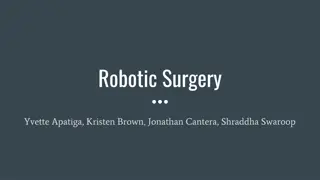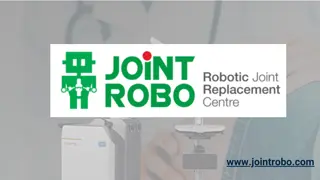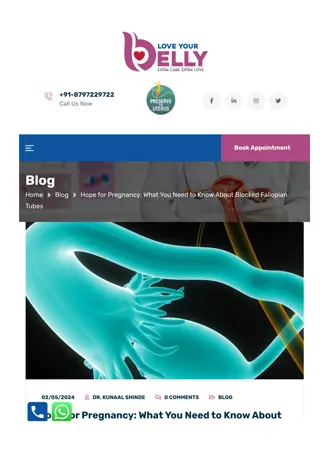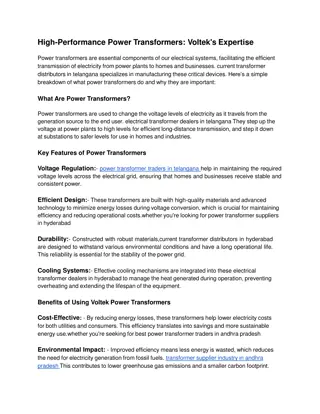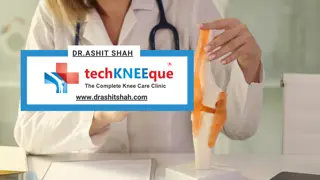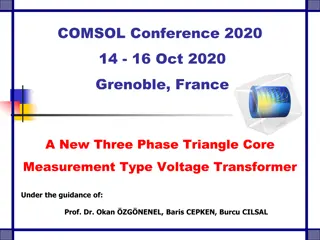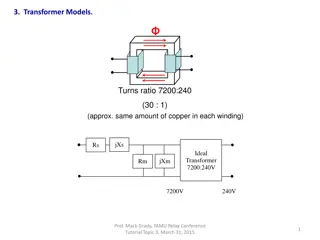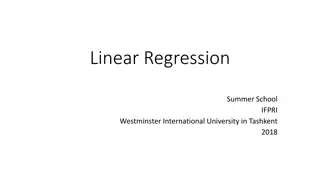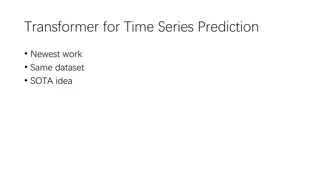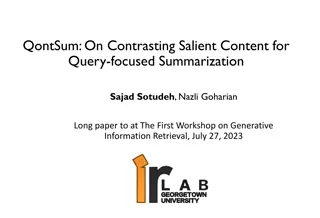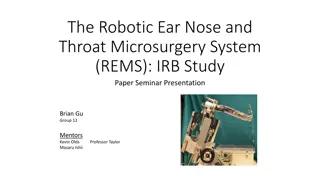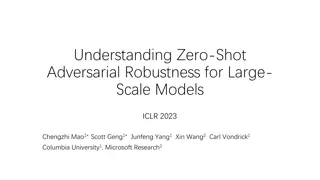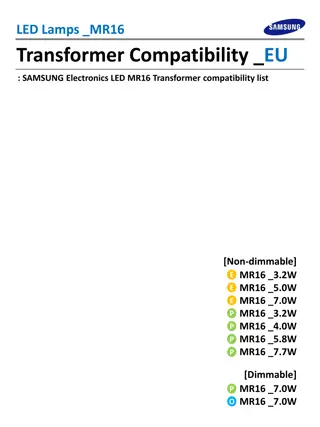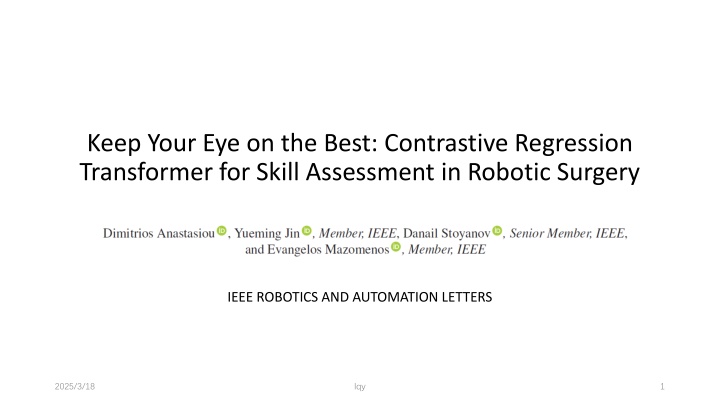
Contrastive Regression Transformer for Skill Assessment in Robotic Surgery
Explore the innovative Contrastive Regression Transformer model, Contra-Sformer, tailored for skill assessment in robotic surgery. This model focuses on expressing the similarity levels between surgical executions, enabling precise evaluation based on spatio-temporal deviations from a reference. Leveraging a contrastive regression framework, the method estimates relative scores between test and reference videos, optimizing performance by utilizing the best-executed reference videos without major errors. The approach integrates Spatio-Temporal Feature Extraction using ResNet-18 and a customized TCN architecture to capture high-level spatial and temporal information, empowering accurate assessment of surgical gestures. Dive into this cutting-edge framework developed to enhance surgical skill evaluation in robotic surgery settings.
Download Presentation

Please find below an Image/Link to download the presentation.
The content on the website is provided AS IS for your information and personal use only. It may not be sold, licensed, or shared on other websites without obtaining consent from the author. If you encounter any issues during the download, it is possible that the publisher has removed the file from their server.
You are allowed to download the files provided on this website for personal or commercial use, subject to the condition that they are used lawfully. All files are the property of their respective owners.
The content on the website is provided AS IS for your information and personal use only. It may not be sold, licensed, or shared on other websites without obtaining consent from the author.
E N D
Presentation Transcript
Keep Your Eye on the Best: Contrastive Regression Transformer for Skill Assessment in Robotic Surgery IEEE ROBOTICS AND AUTOMATION LETTERS 2025/3/18 lqy 1
Background Manual GRS scores have considerable variation (6-30), while the accompanying videos have mostly similar appearance and context Challenging : Distinguish between these scores using only the total score value for supervision Inherent dimensionality reduction of the regression task Recently, the contrastive regression mechanism showed promise in a similar task of action quality assessment (AQA) Encourages the features to encode the difference among different videos. 2025/3/18 lqy 2
Background A novel Contrastive Regression Transformer model, Contra-Sformer Focuses specifically on structuring features to express the level of similarity that each surgical execution (i.e., test video) exhibits when compared to a reference one. Keeping the eye on the best and using it as reference, our model learns how the performance in the input video spatio-temporally deviates from the reference Regression model is optimized for estimating the difference in the GRS score between the two executions. 2025/3/18 lqy 3
Framework 2025/3/18 lqy 4
Method Contrastive Regression From the Best Typically This work A contrastive regression framework that estimates the relative score between an input test video and a reference video instead of regressing to the absolute score of the input Reference video: Execution with the highest available GRS score in the dataset (for each task) Mark: all reference videos are free of major mistakes (e.g., dropping the needle), that may affect the modeling of the similarity/deviation between input and reference. 2025/3/18 lqy 5
Method Spatio-Temporal Feature Extraction ResNet-18: fined-tuned on surgical gesture labels, extract high-level spatial features from ?? gesture label: capture local deviations, sequence and duration of the gestures that constitute each task Training under GRS label supervision will provide features expressing the similarity/deviation between the two videos at a global level Customized TCN architecture: improve temporal information modeling 1D Convolution + 1D Max Pooling+ Batch Normalization 2025/3/18 lqy 6
Method Relation Modeling Via Action-Aware Transformer Straightforward way: Concatenate feature vectors and use for regression This work: Explicitly model the relation by computing the similarity function between corresponding high-level feature vectors Relation modeling: Multi-head attention(8 heads, hidden dim 16, no dropout) Transformer fully connected layer to compute the relative score 2025/3/18 lqy 7
Method Training Procedure End-to end Loss: Mean Squared Error (MSE) and Mean Absolute Error (MAE) A two-step process: First, feature encoder: trained using gesture labels and fixed using the weights corresponding to the minimum cross-entropy loss high-level representation of the video Feature as inputs to the TCN, trained jointly with the rest of the network in an end-to-end manner Whole video sequences, instead of frame clips, are used as inputs 2025/3/18 lqy 8
Experiments Dataset: JIGSAWS Cross-validation schemes: Leave-One-Supertrial-Out (LOSO), Leave-One-User-Out (LOUO), random 4-Fold scheme evaluation metric: SROCC Resized: 240 240, center cropped at 224 224 Augmentation: Random Horizontal Flip with p = 0.1 and Random Rotation of 5 deg are used for KT and NP FPS: 5 Hz 2025/3/18 lqy 9
Experiments 2025/3/18 lqy 10
Ablation Study key design components Selection of the reference video 2025/3/18 lqy 11
Visualizing the Deviation Procedural errors: any deviation from an ideal sequence of surgical gestures Executional errors: poor/failed manipulation of gestures within the task (e.g., needle drop, multiple attempts) 2025/3/18 lqy 12
Conclusions Formulate the regression task based on the skill-similarity/deviation of the test videos compared to a gold-standard reference Transformer fusion model Action segmentation as finetune task 2025/3/18 lqy 13
Writing 2025/3/18 lqy 14
This letter proposes a novel video-based, contrastive regression architecture, Contra- Sformer, for automated surgical skill assessment in robot-assisted surgery. The proposed framework is structured to capture the differences in the surgical performance, between a test video and a reference video which represents optimal surgical execution. A feature extractor combining a spatial component (ResNet-18), supervised on frame-level with gesture labels, and a temporal component (TCN), generates spatiotemporal feature matrices of the test and reference videos. These are then fed into an action-aware Transformer with multi-head attention that produces inter-video contrastive features at frame level, representative of the skill similarity/deviation between the two videos. Moments of sub- optimal performance can be identified and temporally localized in the obtained feature vectors, which are ultimately used to regress the manually assigned skill scores. Validated on the JIGSAWS dataset, Contra-Sformer achieves competitive performance (Spearman 0.65 0.89), with a normalized mean absolute error between 5.8%-13.4% on all tasks and across validation setups. Method & Task Motivation Detailed modules Effect of modules Experiment 2025/3/18 lqy 15
Introduction 1/6 ROBOT-ASSISTED minimally invasive surgery (RMIS) is firmly established in clinical practice, offering enhanced visualization and manipulability compared to standard laparoscopy [1]. Operative performance assessment is a fundamental element of surgical education and practice, and similar to other surgical specialties, significant efforts have been devoted towards standardized objective skill assessment systems for RMIS [2]. Global rating scales (GRS) such as the Objective Structured Assessment of Technical Skills (OSATS) are established assessment tools. The OSATS comprise a list of core procedural components (e.g., handling of instruments, and respect for tissue), assessed and scored on a Likert- style (typically 5-point) scale. Summing the individual GRS components produces an overall performance score (7-35 for OSATS [3]). Each component is assigned a score based on performance characteristics. For example, time and motion is scored with 5 when there is economy of movement, maximum efficiency and optimal outcome [3]. Nevertheless, RMIS evaluation with GRS is time-consuming, laborious and inherently subjective as different evaluators may assess GRS items differently. To address these limitations, several works have developed computational methods that evaluate surgical execution by processing intraoperative information (e.g., surgical video and robot kinematics) [4]. 2025/3/18 lqy 16
Introduction 2/6 Automated surgical skill assessment in RMIS can have a profound impact, streamlining the evaluation process, overcoming the need for manual assessment, and eliminating subjectivity [5]. Modeling optimal surgical execution can also introduce performance awareness in the design of actuation and control policies towards automation of surgical tasks where robotic systems mimic the performance of expert surgeons [1], [4]. The release of the JHU-ISI Gesture and Skill Assessment Working Set (JIGSAWS) [6] containing synchronized kinematics and video captured using the da Vinci Surgical System, alongside atomic gestures and Global Rating Scale (GRS) score annotations (range of 6-30), provided the first structured benchmark to support activity in this space. Several methods for GRS estimation have been developed and validated on JIGSAWS. Initial works utilized kinematic data to regress the GRS score 2025/3/18 lqy 17
Introduction 3/6 Initial works utilized kinematic data to regress the GRS score by exploring different types of holistic features [5], and temporal convolutional neural networks (TCNs) [7]. Reported outcomes indicate that modeling surgical skills to regress GRS scores only using kinematic cues is challenging (Spearman s coefficient: 0.38-0.73). Furthermore, kinematic data are rarely available in real-world RMIS practice. More recent works propose video- or hybrid-based methods, leveraging spatial and temporal feature encoders to extract discriminative features or by usingmulti-task architectures [8], [9], [10], [11], [12], [13], [14], [15], [16], [17], [18]. Tang et al. propose an uncertainty-aware score 1 distribution method based on 3D Convolutional Neural Networks (CNNs), where a distribution of different scores, instead of a single one, acts as the supervisory signal [17]. This method achieves good performance on JIGSAWS and other datasets (AQA-7 and MTL-AQA). Employing surgical gesture information (e.g ., pushing needle through the tissue, orienting needle) can be beneficial for capturing the subtle differences across time, during execution by different surgeons [8]. 2025/3/18 lqy 18
Introduction 3/6 2 3 Wang et al. propose a multi-task learning framework, with primary task the GRS score prediction, and auxiliary tasks of gesture recognition and expertise classification [8]. Li et al. developed ViSA, reporting state-of-the-art performance on JIGSAWS. To model tool-tissue interaction,ViSAclusters local semantic features, produced by a 3D CNN, to generate abstract features for each group (e.g., tools, tissue and background). These are fed to Bidirectional LSTMs and regress the GRS score [14].Multimodal methods combining video and kinematics have also been proposed [2], [19], [20]. Liu et al. propose a unified multi-path framework for surgical skill assessment,with each path focusing onmodeling a different aspect of skill (e.g., semantic visual features, tools, events) [2]. Video features (extracted by ResNet-101), kinematic data, and gesture probabilities (obtained from an MS-TCN) are used. The model is supervised with regression loss and a self-supervised contrastive loss, achieving promising performance (see Table I). 4 2025/3/18 lqy 19
Introduction 4/6 Previous works attempt to directly regress the skill score for the target surgical video from its extracted feature vectors [8], [9], [10], [14], [16], [17], [18]. However, the manual GRS scores in JIGSAWS have considerable variation (6-30), while the accompanying videos have mostly similar appearance and context. Thus, it is challenging for deep models to robustly learn to distinguish between these scores, using only the total score value for supervision. We argue that the inherent dimensionality reduction of the regression task makes it very challenging to structure a model to learn representations that capture the subtle differences observed across the videos. Recently, the contrastive regression mechanism showed promise in a similar task of action quality assessment (AQA) [15]. Instead of learning representations that describe the skill score of a specific video, contrastive regression encourages the features to encode the difference among different videos. - - 2025/3/18 lqy 20
Introduction 5/6 In this letter, we propose a novel Contrastive Regression Transformer model, Contra-Sformer, for surgical skill assessment (formulated as a GRS regression task). Contra-Sformer focuses specifically on structuring features to express the level of similarity that each surgical execution (i.e., test video) exhibits when compared to a reference one. Unlike [15], where the reference video is randomly selected according to the coarse category of the input test video, we set the reference video as the one with the highest assessment score for this particular surgical task. This is motivated by the current surgical training paradigm: an expert surgeon assesses a surgical execution by comparing it to an ideal execution, and deducing points when perceiving deviations. Therefore, keeping the eye on the best and using it as reference, our model learns how the performance in the input video spatio-temporally deviates from the reference. In Contra-Sformer, the regression model is optimized for estimating the difference in the GRS score between the two executions. baseline Motivation 2025/3/18 lqy 21
Introduction 5/6 We argue that by following this contrastive approach we obtain more discriminative and robust features, that are able to better generalize to the varied GRS scores among the different operators. Spatio-temporal feature extraction is implemented with a ResNet-18 and an enhanced TCN architecture. To capture similarities/deviations, we take advantage of the self-attention mechanism and use a multi-head attention block. With this modeling, we aim to encourage the generation of rich intra-video, action and skill-related features, as well as multi- aspect (tool usage, respect for tissue), inter-video features modeled by multi-head attention. Different to [15] where the two signals (i.e. reference, test) are combined with simple concatenation, we introduce multi-head attention to model similarity/deviation between videos. Also, in our work the action knowledge is implicitly embedded in the model by fine-tuning the feature extractor on atomic gestures. That allows the generation of gesture-related features, which help assess skill. This approach is different than others that use multi-task [2], [8] or segment- aware architectures [18] to encode action knowledge. 1 1 baseline 2 2 2025/3/18 lqy 22
Introduction 6/6 We evaluate the Contra-Sformer with Spearman s correlation coefficient (SCC) and Mean Absolute Error (MAE) on three tasks and three cross-validation schemes on JIGSAWS. We also validate the learned features for their ability to represent skill similarity/deviation with ground truth error labels as defined in [21]. Our method achieves competitive performance compared to the state-of-the-art with a 5.8% 13.4% normalized MAE, outperforming current methods on the knot-tying and suturing tasks. Our main contributions are summarized as follows: 1) Propose a novel contrastive regression framework for surgical skill assessment, integrating surgical domain knowledge by contrasting test inputs with a reference, selected as the optimal execution (highest GRS score). 1 framework 2) Derive frame-level spatio-temporal features embedding action/gesture information, combining ResNet-18 outputs with a new temporal convolution network (TCN). 2 embedding module 3) Propose multi-head attention to model the similarity/deviation between the input test and reference video. We show that moments of skill deviation/similarity can be identified from the derived spatio-temporal features. 3 fusion module 4 analysis 4) Perform detailed analysis on the prediction error and introduce the MAE to complement SCC for evaluating regression performance of GRS score prediction in JIGSAWS. 2025/3/18 lqy 23
2025/3/18 lqy 24


